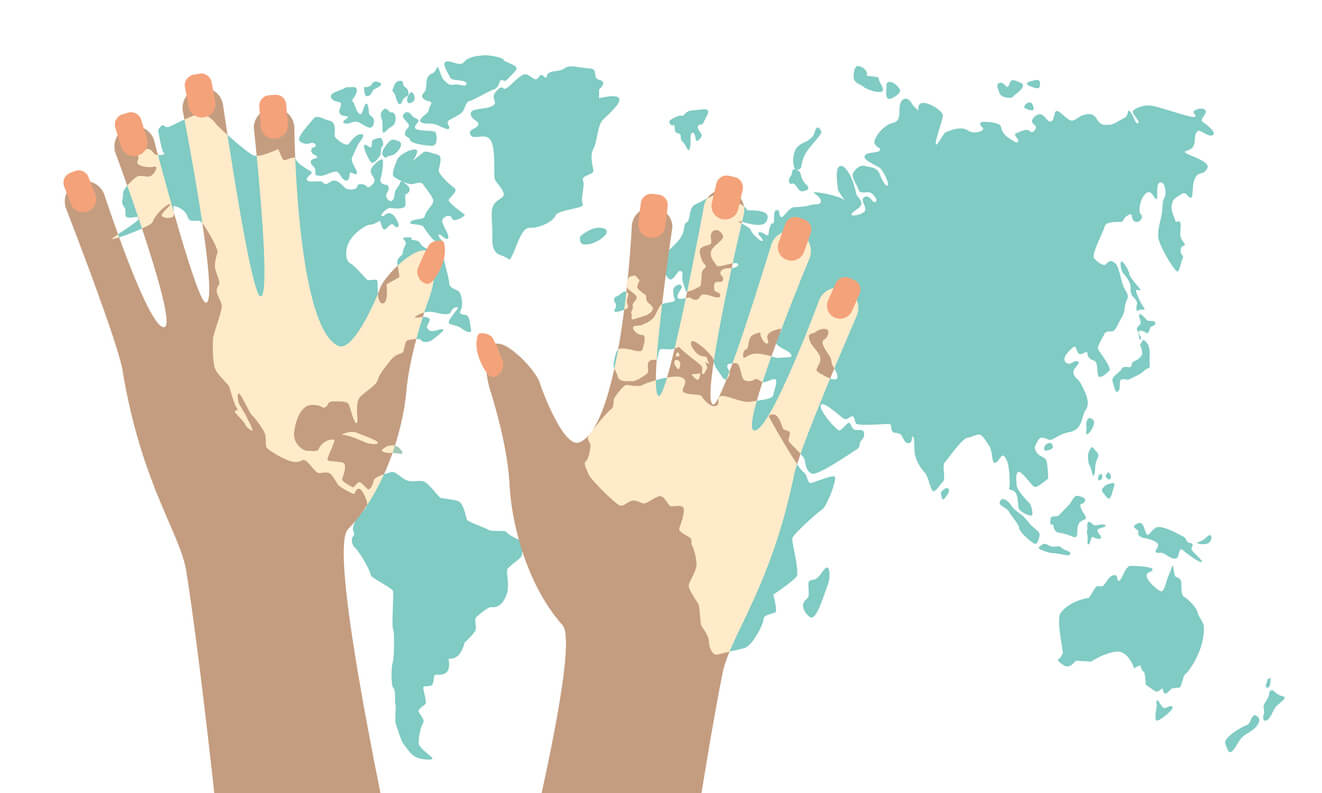9 Tips for Parents of Children with Vitiligo

Vitiligo is a condition that causes some areas of the skin to lose their natural pigmentation. Its cause isn’t clearly known, although it’s thought to be an autoimmune disorder. The diagnosis of this condition can be disconcerting for many parents, and this has a direct impact on the little ones. Therefore, today we’ll provide some useful tips for parents of children with vitiligo so that they can best support them.
There are many myths surrounding the condition, as well as a general lack of knowledge. Unwittingly, many adults can be exposed to them, whether they’re the parents or those who make up the child’s inner circle. Therefore, it’s key to know how to act after diagnosis to promote the well-being of the whole family.
The top tips for parents of children with vitiligo
Experts state that half of the patients with vitiligo develop the disease before the age of 20, and about 25% do so before the age of 8.
A study published in the Journal of Patient-Reported Outcomes found that the diagnosis can have a major impact on the psychosocial health of parents. Distress, withdrawal, and insecurity are some initial reactions in these cases. All of these feelings are normal, and they subside as time passes.
Increased knowledge of the disease and words of encouragement from medical specialists are helpful. In the process, a number of tips can be followed that guide both the psychosocial health of the parents and the overall well-being of their children. We’ll review 9 of them.
1. Turn to support groups
For many parents, surrounding themselves with a community or support group is a great help in coping with a diagnosis of vitiligo. Through social media, forums, and websites, you can find hundreds and hundreds of groups offering support to parents of children with vitiligo. You can also search for local groups and attend meetings in person.
Through these groups, you can connect with the experience of other parents in your position and learn about their thoughts, reactions, and feelings about the diagnosis. Likewise, you can be aware of how other parents have supported their children. Again, it’s natural for the initial reaction to be one of distress and you can clear much of this with the help of a supportive community.

2. Watch for warning signs
Researchers report that the well-being of children with vitiligo can be significantly affected, and this occurs under a spectrum of negative experiences. Substantial trauma, distress, anxiety, depression, and social stigma are just a few of the most frequent factors that can surround the disease. Therefore, being attentive to psychosocial signs in your child is essential to be able to better accompany them regarding their condition.
There are certain signs that may indicate the above experiences, but the most important and obvious one is the change in your child’s behavior. Any type of alteration should be brought to your attention, especially when it goes along the lines of unexpected mood swings. Also, if they display refusal to attend social spaces (school, mainly), develop mutism, shyness, or changes in sleeping patterns or eating habits.
3. Encourage your child to participate in social activities
We want to be clear on one thing: Encouraging doesn’t mean forcing. Encourage your child to participate in volunteer activities or after-school programs, attend friends’ birthday celebrations, go to the beach and swimming pools, and enjoy any similar experience. This isn’t something you should force, but rather encourage them to create a social circle.
It’s key that the child participates in these types of social events, as withdrawal is very common in children with vitiligo. By feeling different (and looking different) they may choose to isolate themselves because they believe they’re not included.
Encouraging their participation in activities of this type will help your child understand that looking different doesn’t make them different from others.
4. Teach your child what vitiligo is and what it’s not
Following on from the previous thought, another tip for parents of children with vitiligo is to inform them correctly about their health condition. Starting by explaining what vitiligo is not is very useful, as they, their friends, and the circle around them often assume erroneous prejudices. We’ll review some of the myths surrounding vitiligo:
- It’s not a physical or mental disability.
- It’s not a contagious or infectious disease.
- It’s not exclusive to people with a dark complexion.
- It’s not a type of skin cancer or albinism.
It’s important that you also create awareness about the condition among the parents of your child’s friends so that they can inform their little ones properly. When this happens, they’ll stop staring at your child’s spots, asking insistent questions, and distancing themselves out of fear that they’ll catch the disease.
Be dynamic in your explanations about vitiligo, as knowledge on this point will translate into safety and confidence for the child.

5. Don’t pressure your child to cover or uncover their spots
A common mistake made by many parents of children with vitiligo is to pressure their little ones to cover or uncover their skin spots. Both actions are inappropriate, as it’s ultimately up to the child to decide how and when to do it.
Forcing them to cover up can always delay acceptance and lead them to think that it’s “bad”.
At the same time, encouraging them to uncover their spots can lead to completely omitting their emotions, feelings, and concerns about their condition.
Let the child choose whether or not to cover up their spots and always let them know that depigmentation doesn’t define them, make them inferior to others, or limit them in any way. As we’ve already stated, their knowledge of the condition will be their greatest strength.
6. Learn about treatment options
Another essential tip for parents of children with vitiligo is to seek reliable information about treatment alternatives. Not all therapies for vitiligo are available for children and this is something the specialist should make you aware of.
While the treatment options are more limited, there’s a varied spectrum. The best treatments, according to experts, are as follows:
- Narrowband UVB treatment
- PUVA light therapy
- Topical medications
- Cosmetic camouflage
- Surgical modalities (not first-line treatments)
Discuss with a specialist which options are best according to the characteristics of your little one’s depigmentation. Although there’s no cure for vitiligo, there are several alternatives that can help delay its progression and favor repigmentation.
7. Seek psychological support for your little one
Specialists recommend cognitive behavioral therapy, psychological self-help tools, and support groups to cope with psychosocial aspects of childhood vitiligo.
As we’ve already mentioned, the emotional consequences of depigmentation in children can be significant, so psychological therapy isn’t a complementary alternative, but a priority.
Even when there are no visible signs of behavioral or emotional disturbances, it’s always advisable to resort to psychological therapy. With the help of qualified professionals, it’s possible to reinforce positive feelings towards the condition, which will increase the child’s self-esteem, self-confidence, and psychosocial well-being.

8. Raise your child’s awareness about the care of areas with depigmentation
Since they’ll have to live with the condition permanently, your little one should learn some basic prevention habits. For example, apply sunscreen daily, stay as long as possible in the shade, reduce stress, take care of their diet, and don’t abandon treatment.
In principle, it’s you who’ll be in charge of ensuring all this, but it’s important that you encourage their adherence and participation from an early age. That way, they’ll be much more likely to will incorporate the care measures as part of their life habits and maintain them in adolescence and adulthood.
9. Ensure wellness and fun for your little one
Finally, complement all of the above recommendations with activities that ensure wellness and fun for your little one. This advice may seem naïve, but the truth is that it has many direct benefits for your child: It strengthens the bond that unites them, boosts their self-confidence, develops their potential, distracts their thoughts about depigmentation, and promotes their happiness.
The actions of parents have a great impact on the lives of their children
If you take into account all these tips for parents of children with vitiligo, you’ll ensure your child’s well-being and your own. We recommend that you couple them with the recommendations of a specialist and follow the professional’s indications on how to deal with the diagnosis. Vitiligo isn’t disabling and it’s the duty of parents to let their children know this.
Vitiligo is a condition that causes some areas of the skin to lose their natural pigmentation. Its cause isn’t clearly known, although it’s thought to be an autoimmune disorder. The diagnosis of this condition can be disconcerting for many parents, and this has a direct impact on the little ones. Therefore, today we’ll provide some useful tips for parents of children with vitiligo so that they can best support them.
There are many myths surrounding the condition, as well as a general lack of knowledge. Unwittingly, many adults can be exposed to them, whether they’re the parents or those who make up the child’s inner circle. Therefore, it’s key to know how to act after diagnosis to promote the well-being of the whole family.
The top tips for parents of children with vitiligo
Experts state that half of the patients with vitiligo develop the disease before the age of 20, and about 25% do so before the age of 8.
A study published in the Journal of Patient-Reported Outcomes found that the diagnosis can have a major impact on the psychosocial health of parents. Distress, withdrawal, and insecurity are some initial reactions in these cases. All of these feelings are normal, and they subside as time passes.
Increased knowledge of the disease and words of encouragement from medical specialists are helpful. In the process, a number of tips can be followed that guide both the psychosocial health of the parents and the overall well-being of their children. We’ll review 9 of them.
1. Turn to support groups
For many parents, surrounding themselves with a community or support group is a great help in coping with a diagnosis of vitiligo. Through social media, forums, and websites, you can find hundreds and hundreds of groups offering support to parents of children with vitiligo. You can also search for local groups and attend meetings in person.
Through these groups, you can connect with the experience of other parents in your position and learn about their thoughts, reactions, and feelings about the diagnosis. Likewise, you can be aware of how other parents have supported their children. Again, it’s natural for the initial reaction to be one of distress and you can clear much of this with the help of a supportive community.

2. Watch for warning signs
Researchers report that the well-being of children with vitiligo can be significantly affected, and this occurs under a spectrum of negative experiences. Substantial trauma, distress, anxiety, depression, and social stigma are just a few of the most frequent factors that can surround the disease. Therefore, being attentive to psychosocial signs in your child is essential to be able to better accompany them regarding their condition.
There are certain signs that may indicate the above experiences, but the most important and obvious one is the change in your child’s behavior. Any type of alteration should be brought to your attention, especially when it goes along the lines of unexpected mood swings. Also, if they display refusal to attend social spaces (school, mainly), develop mutism, shyness, or changes in sleeping patterns or eating habits.
3. Encourage your child to participate in social activities
We want to be clear on one thing: Encouraging doesn’t mean forcing. Encourage your child to participate in volunteer activities or after-school programs, attend friends’ birthday celebrations, go to the beach and swimming pools, and enjoy any similar experience. This isn’t something you should force, but rather encourage them to create a social circle.
It’s key that the child participates in these types of social events, as withdrawal is very common in children with vitiligo. By feeling different (and looking different) they may choose to isolate themselves because they believe they’re not included.
Encouraging their participation in activities of this type will help your child understand that looking different doesn’t make them different from others.
4. Teach your child what vitiligo is and what it’s not
Following on from the previous thought, another tip for parents of children with vitiligo is to inform them correctly about their health condition. Starting by explaining what vitiligo is not is very useful, as they, their friends, and the circle around them often assume erroneous prejudices. We’ll review some of the myths surrounding vitiligo:
- It’s not a physical or mental disability.
- It’s not a contagious or infectious disease.
- It’s not exclusive to people with a dark complexion.
- It’s not a type of skin cancer or albinism.
It’s important that you also create awareness about the condition among the parents of your child’s friends so that they can inform their little ones properly. When this happens, they’ll stop staring at your child’s spots, asking insistent questions, and distancing themselves out of fear that they’ll catch the disease.
Be dynamic in your explanations about vitiligo, as knowledge on this point will translate into safety and confidence for the child.

5. Don’t pressure your child to cover or uncover their spots
A common mistake made by many parents of children with vitiligo is to pressure their little ones to cover or uncover their skin spots. Both actions are inappropriate, as it’s ultimately up to the child to decide how and when to do it.
Forcing them to cover up can always delay acceptance and lead them to think that it’s “bad”.
At the same time, encouraging them to uncover their spots can lead to completely omitting their emotions, feelings, and concerns about their condition.
Let the child choose whether or not to cover up their spots and always let them know that depigmentation doesn’t define them, make them inferior to others, or limit them in any way. As we’ve already stated, their knowledge of the condition will be their greatest strength.
6. Learn about treatment options
Another essential tip for parents of children with vitiligo is to seek reliable information about treatment alternatives. Not all therapies for vitiligo are available for children and this is something the specialist should make you aware of.
While the treatment options are more limited, there’s a varied spectrum. The best treatments, according to experts, are as follows:
- Narrowband UVB treatment
- PUVA light therapy
- Topical medications
- Cosmetic camouflage
- Surgical modalities (not first-line treatments)
Discuss with a specialist which options are best according to the characteristics of your little one’s depigmentation. Although there’s no cure for vitiligo, there are several alternatives that can help delay its progression and favor repigmentation.
7. Seek psychological support for your little one
Specialists recommend cognitive behavioral therapy, psychological self-help tools, and support groups to cope with psychosocial aspects of childhood vitiligo.
As we’ve already mentioned, the emotional consequences of depigmentation in children can be significant, so psychological therapy isn’t a complementary alternative, but a priority.
Even when there are no visible signs of behavioral or emotional disturbances, it’s always advisable to resort to psychological therapy. With the help of qualified professionals, it’s possible to reinforce positive feelings towards the condition, which will increase the child’s self-esteem, self-confidence, and psychosocial well-being.

8. Raise your child’s awareness about the care of areas with depigmentation
Since they’ll have to live with the condition permanently, your little one should learn some basic prevention habits. For example, apply sunscreen daily, stay as long as possible in the shade, reduce stress, take care of their diet, and don’t abandon treatment.
In principle, it’s you who’ll be in charge of ensuring all this, but it’s important that you encourage their adherence and participation from an early age. That way, they’ll be much more likely to will incorporate the care measures as part of their life habits and maintain them in adolescence and adulthood.
9. Ensure wellness and fun for your little one
Finally, complement all of the above recommendations with activities that ensure wellness and fun for your little one. This advice may seem naïve, but the truth is that it has many direct benefits for your child: It strengthens the bond that unites them, boosts their self-confidence, develops their potential, distracts their thoughts about depigmentation, and promotes their happiness.
The actions of parents have a great impact on the lives of their children
If you take into account all these tips for parents of children with vitiligo, you’ll ensure your child’s well-being and your own. We recommend that you couple them with the recommendations of a specialist and follow the professional’s indications on how to deal with the diagnosis. Vitiligo isn’t disabling and it’s the duty of parents to let their children know this.
All cited sources were thoroughly reviewed by our team to ensure their quality, reliability, currency, and validity. The bibliography of this article was considered reliable and of academic or scientific accuracy.
- Andrade G, Rangu S, Provini L, Putterman E, Gauthier A, Castelo-Soccio L. Childhood vitiligo impacts emotional health of parents: a prospective, cross-sectional study of quality of life for primary caregivers. J Patient Rep Outcomes. 2020;4(1):20. Published 2020 Mar 20.
- Cadmus SD, Lundgren AD, Ahmed AM. Therapeutic interventions to lessen the psychosocial effect of vitiligo in children: A review. Pediatr Dermatol. 2018 Jul;35(4):441-447.
- Gianfaldoni S, Tchernev G, Wollina U, et al. Vitiligo in Children: A Better Understanding of the Disease. Open Access Maced J Med Sci. 2018;6(1):181-184. Published 2018 Jan 20.
- Grimes PE, Miller MM. Vitiligo: Patient stories, self-esteem, and the psychological burden of disease. Int J Womens Dermatol. 2018;4(1):32-37. Published 2018 Jan 8.
- Kanwar AJ, Kumaran MS. Childhood vitiligo: treatment paradigms. Indian J Dermatol. 2012;57(6):466-474.
This text is provided for informational purposes only and does not replace consultation with a professional. If in doubt, consult your specialist.








